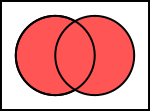
Back فصل منطقي Arabic Dizyunksiya Azerbaijani Дизюнкция Bulgarian Disjunkcija sudova BS Disjunció Catalan Disjunkce Czech Disjunktion Danish Disjunktion German Λογική διάζευξη Greek Diśgiunsiòun lògica EML
| OR | |
|---|---|
 | |
| Definition | |
| Truth table | |
| Logic gate | |
| Normal forms | |
| Disjunctive | |
| Conjunctive | |
| Zhegalkin polynomial | |
| Post's lattices | |
| 0-preserving | yes |
| 1-preserving | yes |
| Monotone | yes |
| Affine | no |
| Logical connectives | ||||||||||||||||||||||
|---|---|---|---|---|---|---|---|---|---|---|---|---|---|---|---|---|---|---|---|---|---|---|
|
||||||||||||||||||||||
| Related concepts | ||||||||||||||||||||||
| Applications | ||||||||||||||||||||||
|
| ||||||||||||||||||||||

In logic, disjunction, also known as logical disjunction or logical or or logical addition or inclusive disjunction, is a logical connective typically notated as and read aloud as "or". For instance, the English language sentence "it is sunny or it is warm" can be represented in logic using the disjunctive formula , assuming that abbreviates "it is sunny" and abbreviates "it is warm".
In classical logic, disjunction is given a truth functional semantics according to which a formula is true unless both and are false. Because this semantics allows a disjunctive formula to be true when both of its disjuncts are true, it is an inclusive interpretation of disjunction, in contrast with exclusive disjunction. Classical proof theoretical treatments are often given in terms of rules such as disjunction introduction and disjunction elimination. Disjunction has also been given numerous non-classical treatments, motivated by problems including Aristotle's sea battle argument, Heisenberg's uncertainty principle, as well as the numerous mismatches between classical disjunction and its nearest equivalents in natural languages.[1][2]
An operand of a disjunction is a disjunct.[3]
- ^ Aloni, Maria (2016), "Disjunction", in Zalta, Edward N. (ed.), The Stanford Encyclopedia of Philosophy (Winter 2016 ed.), Metaphysics Research Lab, Stanford University, retrieved 2020-09-03
- ^ "Disjunction | logic". Encyclopedia Britannica. Retrieved 2020-09-03.
- ^ Beall, Jeffrey C. (2010). Logic: the basics. The basics (1. publ ed.). London: Routledge. p. 57. ISBN 978-0-203-85155-5.
© MMXXIII Rich X Search. We shall prevail. All rights reserved. Rich X Search












































